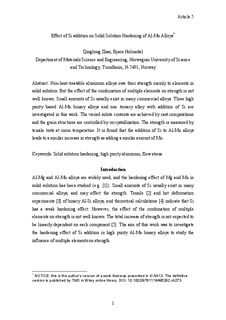| dc.contributor.advisor | Holmedal, Bjørn | nb_NO |
| dc.contributor.author | Zhao, Qinglong | nb_NO |
| dc.date.accessioned | 2014-12-19T13:26:58Z | |
| dc.date.available | 2014-12-19T13:26:58Z | |
| dc.date.created | 2013-01-22 | nb_NO |
| dc.date.issued | 2013 | nb_NO |
| dc.identifier | 599794 | nb_NO |
| dc.identifier.isbn | 978-82-471-4122-9 (electronic version) | nb_NO |
| dc.identifier.isbn | 978-82-471-4121-2 (printed version) | nb_NO |
| dc.identifier.uri | http://hdl.handle.net/11250/249216 | |
| dc.description.abstract | The relationship between the processing, the structure and the properties is a key issue of materials science research. The improvement of the properties and optimization of the process always requires a better understanding of the relationship. For structural materials, the mechanical properties are the most concerned. The objective of this thesis is to investigate the influence of structural variables, i.e. dispersoids and solutes, on the strengthening and work hardening behavior of aluminum alloys.
An Al-Mn-Fe-Si model alloy was used to investigate the influence of dispersoids on work hardening. This model alloy had similar composition as the commercial AA3103 alloy. After homogenization, the alloy contains fine dispersoids, coarse constituent particles and solutes in solid solution. Therefore, this alloy provides a complex system to study, which is of academic and industrial interest. The work hardening behavior of as-homogenized and cold-rolled alloys was tested by tension at room temperature. The corresponding microstructure was characterized by transmission and scanning electron microscope. The strengthening mechanisms during deformation were discussed, including Orowan stress and internal stress. It is found that a high density of fine dispersoids strengthens the alloy significantly, but their effect diminishes as strain increases. The work hardening rate is increased due to the extra dislocations induced by dispersoids during the initial deformation, but it is reduced at larger strains. After experimental investigation of the effect of dispersoids on work hardening, it was attempted to model the effect. A simplified model of dislocation evolution affected by dispersoids was proposed.
Solid solution hardening has been investigated for decades, but the mechanism in a multi-component solid solution has not yet been fully clarified. Commercial aluminum alloys usually contain several alloying elements besides trace elements. The effect of each element and the interaction between these elements are not well understood. The effect of trace elements on the strengthening of commercially pure aluminum was investigated in this work. A high-purity base aluminum with addition of Si and Fe was compared to a commercial-purity aluminum containing similar content of Si and Fe. Their mechanical properties are found to be similar, suggesting that trace elements play a minor role in strengthening.
Solute strengthening in Al-Si alloys of commercial purity was investigated by tensile testing of several Al-Si alloys at room temperature. The effect of Si on strengthening and work hardening was quantitatively characterized. Quenching is found to affect the solution hardening at small strains. After a study on solute strengthening in binary alloys, solute strengthening in alloys containing several elements can be studied. The multi-component hardening was investigated by comparison of an Al-Mn-Si ternary alloy and Al-Mn binary alloys. The multi-component superposition is usually applied under the assumption of no interaction between each element. However, experimental results suggest that this simple superposition can not explain the hardening in the ternary alloy. Clustering is assumed to cause the hardening of the ternary alloy. | nb_NO |
| dc.language | eng | nb_NO |
| dc.publisher | Norges teknisk-naturvitenskapelige universitet | nb_NO |
| dc.relation.ispartofseries | Doktoravhandlinger ved NTNU, 1503-8181; 2013:16 | nb_NO |
| dc.relation.haspart | Zhao, Qinglong; Holmedal, Bjørn; Li, Yanjun. Influence of dispersoids on microstructure evolution and work hardening of aluminumalloys during tension and cold rolling. Philosophical Magazine. (ISSN 1478-6435): 1-17, 2013. <a href='http://dx.doi.org/10.1080/14786435.2013.794315'>10.1080/14786435.2013.794315</a>. | nb_NO |
| dc.relation.haspart | Zhao, Qinglong; Holmedal, Bjørn. Modeling work hardening of aluminum alloys containing dispersoids. Philosophical Magazine. (ISSN 1478-6435): 1-12, 2013. <a href='http://dx.doi.org/10.1080/14786435.2013.805271'>10.1080/14786435.2013.805271</a>. | nb_NO |
| dc.relation.haspart | Zhao, Qinglong; Holmedal, Bjørn; Slagsvold, Marius. Comparison of the influence of Si and Fe in 99.999% purity aluminum and in commercial-purity aluminum. Scripta Materialia. (ISSN 1359-6462). 67: 217-220, 2012. | nb_NO |
| dc.relation.haspart | Zhao, Qinglong; Holmedal, Bjørn. The effect of silicon on the strengthening and work hardening of aluminum at room temperature. Materials Science & Engineering - A. (ISSN 0921-5093). 563: 147-151, 2013. <a href='http://dx.doi.org/10.1016/j.msea.2012.11.062'>10.1016/j.msea.2012.11.062</a>. | nb_NO |
| dc.relation.haspart | Zhao, Qinglong; Holmedal, Bjørn. Effect of Si Additions on Solid Solution Hardening of Al-Mn Alloys. , 2012. <a href='http://dx.doi.org/10.1002/9781118495292.ch273'>10.1002/9781118495292.ch273</a>. | nb_NO |
| dc.title | The influence of Mn, Fe and Si on the work hardening of aluminum alloys | nb_NO |
| dc.type | Doctoral thesis | nb_NO |
| dc.contributor.department | Norges teknisk-naturvitenskapelige universitet, Fakultet for naturvitenskap og teknologi, Institutt for materialteknologi | nb_NO |
| dc.description.degree | PhD i materialteknologi | nb_NO |
| dc.description.degree | PhD in Materials Science and Engineering | en_GB |





